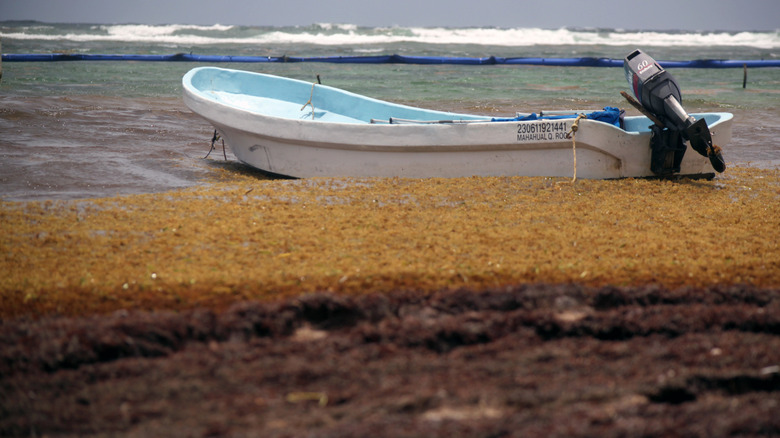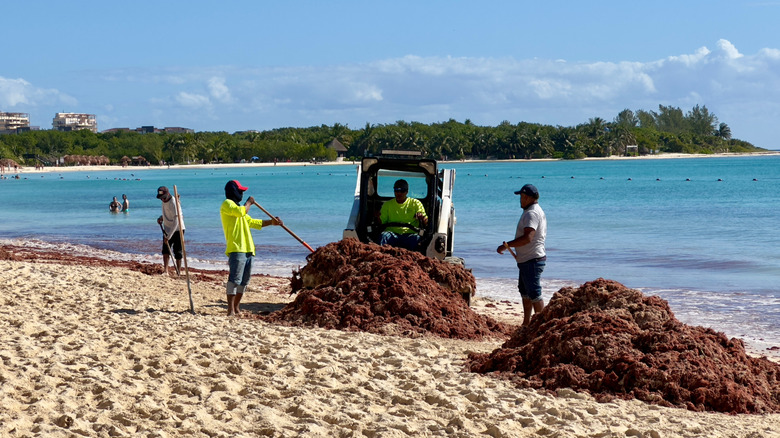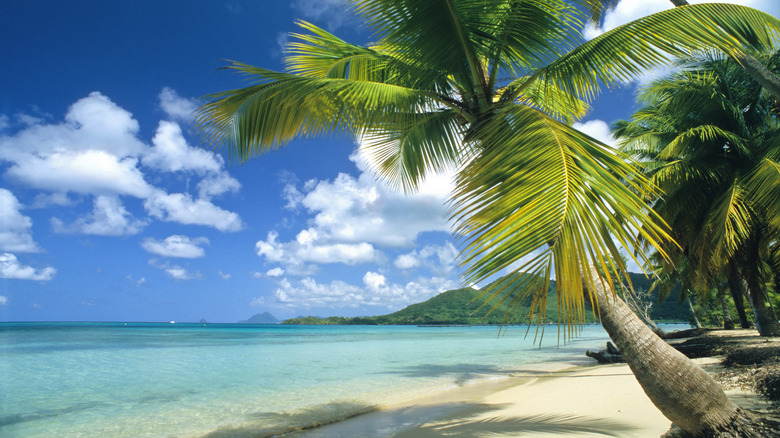The Ugly Natural Phenomenon Totally Decimating The Caribbean's White Beaches
The inviting white-sand beaches and aquamarine inshore waters of many a Caribbean isle are now foul-smelling lagoons laden with noxious, decaying seaweed. Sargassum is actually a naturally occurring algae that blooms in the warm waters of the Sargasso Sea far out in the north-central Atlantic Ocean. But industrial and agricultural pollution running into the Atlantic from rivers on four continents is contributing to significantly elevated levels of nitrates and phosphates in the sea, and those excessive nutrients are creating bumper crops of sargassum. Thanks to the circular currents of the Atlantic, these giant matts of seaweed are delivered to the doorsteps of some of the best beaches in the Caribbean, where the seaweed washes ashore and rots in stinky blobs that keeps tourists away from the water.
Sargussum, in normal amounts, is a good thing. The seaweed, kept afloat by little gas-filled berries, provides important habitat for everything from fish to crustaceans, like crabs and shrimp. But when ocean currents deliver unnatural amounts of sargassum into the calmer waters of the Caribbean tropics, and it ends up in the shallows over sea grass, it can become very problematic, both for the environment and the Caribbean's vital tourism industry. It can block the sunlight from reaching sea grass on shallows flats, inhibiting photosynthesis. As it nears shore and decays, the algae turns the water a rusty orange, and the stench is palpable.
What is being done to combat the Caribbean's sargassum bloom?
The current explosion of sargassum growth started in earnest in 2011. And, ironically, its impacts on the sandy beaches and some of the best snorkeling spots in the Caribbean are not of the region's doing. Nevertheless, the economic impact on the tropics and the island nations in the region that depend heavily on a healthy ocean is significant. When large matts of the seaweed make their way onto otherwise pristine beaches, tourists are less inclined to visit, meaning fewer tourists arrive in Caribbean countries that depend heavily on visitors. When sargassum washes ashore, it quickly starts to decay and emits a foul stench of hydrogen sulfide.
Across the Caribbean, countries are working to remove the ill-smelling algae, both from beaches and, in some cases, from inshore waters using floating booms that trap the matts of seaweed before it hits the sand. Some entrepreneurs are exploring ways to use the seaweed for things like cattle feed, fertilizer or even as concrete for construction. But, so far, these efforts have only achieved small-scale success. Unfortunately, removal efforts are expensive. For example, the Miami-Dade County Department of Parks, Recreation, and Open Spaces estimates a $45 million annual cost for continued sargassum removal on just 15 miles of Florida beaches.
How can tourists avoid sargassum in the Caribbean?
While some areas of the Caribbean, like Mexico's Riviera Maya, are more acutely impacted by sargassum, others report beaches and reefs that are largely free of the floating masses of seaweed. Even countries that are in the "bulls' eye" for sargassum impacts report that the seaweed inundation is generally seasonal — when cooler ocean temperatures prevail from November through April, the impacts of sargassum are noticeably less acute. That said, if visitors to the tropics want to avoid sargassum at all costs, there are options.
For instance, Jamaica reports that most of the beaches on its southern shores are not greatly impacted by sargassum. Certain beaches in Antigua are also reportedly free of sargassum, as are some of Curacao's Caribbean beaches. The takeaway? Nearly all countries in the Caribbean are dealing with the sargassum crisis, but some beaches, depending on prevailing winds and ocean currents, see less sargassum accumulation. The key to avoiding the sargassum when traveling is to invest time and energy into research and to avoid certain high-impact areas during the warmer months. For now, the sargassum bloom is the new normal in the Caribbean, which is a shame, because these countries aren't the cause of the excessive seaweed.


